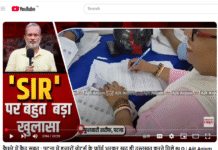
Stories of digital transformation, harnessing artificial intelligence and technology in the news media business, why there is a lack of women in leadership roles, the need for data strategies, print versus digital, driving digital revenue, and the future outlook were the highlights of the three-day Wan-Ifra Indian Media Leaders eSummit on held 18, 19 and 20 July.
Chief executive officers, publishers, editors, business heads, and other leaders from across print and digital functions met virtually to discuss the challenges and come up with fresh ideas and strategic directions to drive the news media business.
K N Shanth Kumar, director, The Printers Mysore – publisher of brands such as Deccan Herald and Prajavani – and member of the board, of Wan-Ifra, set the tone for the event, highlighting the changing face of media over the years. He spoke on how technology such as AI is changing the media landscape, the need for an audience-first strategy, how data is the backbone of the digital economy and effective game plans are needed to drive digital revenue.
Most panelists echoed Kumar’s views to better plan for a digital future but the approaches were a tad different.
Leaders from news media organizations abroad, especially the West, shared their stories of transformation and how made a rapid shift from a terminally ill print media to a newer and brighter future with digital. Their views on print were specific – it could be a value-added product to complement digital but not the mainstay.
Fredric Karèn, the senior vice-president for editorial transformation at Schibsted, was quite straightforward when he said that digital should be in charge. He suggested breaking of old print rules on layout and photos that stopped editors from thinking out of the box.

“The decision-making should be with digital, not print. Shift the best resources to digital…spend less time on print. We have to make a clear choice,” he said. In Scandinavia, print media was profitable in 2012 but the tables turned very quickly, he said, and suggested Indian news media owners should take small but definitive steps so that they are not caught off-guard later on.
Their Indian counterparts, on the other hand, felt it was a long way to go before print media ran out of steam in the country. They were, however, unanimous in saying that digital was the future – it was a matter of when – and debated ways and means to better monetize online news in the Indian context.
In the CEO sessions on Day 1, the editorial and business leads of leading media houses harped on the credibility of print media.
Jayant Mammen Mathew, executive editor & director, Malayala Manorama; Samudra Bhattacharya, CEO, Print, HT Media; Pawan Agarwal, deputy managing director, DB Corp; and Sitaraman Shankar, editor Deccan Herald and CEO, The Printers Mysore, agreed that though the pandemic spurred the growth of digital, it led a spurt in misinformation and fake news, which worked in favor of the print media.
They all, however, concurred that a change in strategy was needed to lure the digital-first generation to print media with snappier and engaging content, explainers, going beyond the news, more local news, etc.
Talking about digital, they all felt that only real journalism, and not click-bait articles, can compel subscribers to pay for good content. The story-telling format, though, would be different for the younger generation, which prefers videos and more multimedia elements.
In another session on Day 3, Puneet Jain, CEO, HT Digital News; Sanjay Sindhwani, CEO, Indian Express Online; Mayura Shreyamskumar, director, Digital Business, Mathrubhumi Group; and Puneet Gupt, COO, Times Internet discussed the monetary aspects, paywalls for news, the use of data, the Indian versus the western context and how it is a long way to go before online news can match print in terms of revenue – though a good beginning has been made.
Sindhwani explained that though the pandemic led to a big digital surge, the hype was short-lived and there was a correction after everything opened up and newspapers came back to circulation. The slowdown in the West also affected the digital economy in India, he said.
“The challenge is how to grow subscription into a sustainable substantial business and how to optimize ad business. Digital is at a nascent stage in India, where readers are not willing to pay. The big tech is taking away a chunk of the revenue. We are spending money but the returns are uncertain,” Sindhwani said.
Puneet Gupt of Times said there has been a steady rise in the group’s websites but the growth rates vary. “You need a different DNA to drive readers and a different strategy to get ads. It is a tough battle but digital will overtake print in terms of value sooner or later.”
Puneet Jain of HT Media said these are challenging times for the media, which is undergoing a transformation from print to digital, TV to digital, and now digital to AI.
“We have to prioritize users, we have to prioritize engagement over reach. 10 users coming 10 times a month is better than 100 users coming once a month. We need returning and loyal users. We need newsroom transformations for the battle ahead, which is not easy,” Jain said.
Getting readers to pay for online content is one of the biggest challenges, and this was articulated across sessions, be it the Indian media leaders or those from the West. The common refrain was that only credible journalism and local and differentiated content can force readers to pay.
On the use of AI, while the news media in the West has already started embracing the tool either for content generation, targeting readers, or identifying news angles, the Indian media is still adopting a wait-and-watch approach as seen from the responses from most stakeholders. “We can use AI to multiply content but it is a double-edged sword. AI can help optimize content but can also be used to spread misinformation,” Jain said.
Sidhwani and Jain said media houses have to invest in tech and data to know the audiences as subscriptions will help them know the customers in a better way. The big tech, Jain said, have data and they use it to their advantage for a targeted approach.
In an interesting session, Michael Miller, executive chairman of News Corp Australasia explained how they transformed into an audience-centric organization and garnered one million paying subscribers for their digital properties. Create exclusive content and special content people will pay for, he said. To a question on the Australia news bargaining code and if it can be implemented in India, he said it is up to the government to take up the issue.
On the whole, a key takeaway from the summit was that though the Indian news media is waking up to the digital reality, blindly aping the West may not yield the same results as the ground realities are different. But it is better to be well-prepared for the battle ahead from now on than rather be caught-off guard later, as Karèn put it succinctly.














